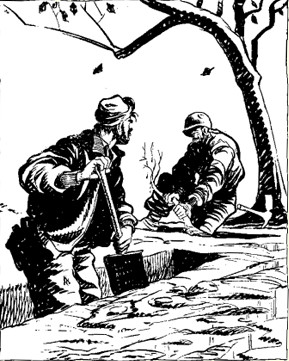
Offered a medal by the company medic, slightly wounded Willie shrugs: “Just give me the aspirin. Willie and Joe struck a universal chord with real-life soldiers because there was no fakery to them, and no false bravado.

“When we ain’t fightin’ we should ack like sojers.” An Enlisted Man’s Cartoon “He’s right, Joe,” says Willie in one cartoon after a spit-and-polish officer criticizes their slovenly dress. The pair suffered rain, pain, fear, boredom, fleas, hunger, thirst, and, not least of all, self-important, rear-echelon officers. Whether Willie and Joe were dodging shells, taking a quick bath in a mud hole, or merely trudging forward, one step at a time, they were the true expression of a particularly American vision of war as something to be endured-and won-but never glorified. Their undifferentiated anonymity reflected the impersonal quality of the combat infantryman’s life (and death) and made them easier for other soldiers to identify with. Sharp-nosed Willie (modeled on Mauldin’s hard-drinking father, Pop) and pug-nosed Joe (Mauldin himself) were virtually indistinguishable from their fellow soldiers. It’s a southwestern sort of trait, really. They know how to walk in the mud and how to shoot. They’re not happy doing what they’re doing, but they’re not totally fish out of water, either.


“People like that really make ideal infantry soldiers. “These guys were based on these Oklahomans I knew,” Mauldin said later.

Their creator, a 22-year-old lefthander from the mountains of New Mexico, based Willie and Joe on his fellow southwesterners in Company K, 180th Infantry Regiment, 45th Division. They were an immediate hit, striking a chord of rueful self-recognition with readers, who saw in the unshaven pair of reluctant warriors an accurate and unsentimental depiction of a soldier’s life at the front in the third long year of America’s war. Willie and Joe, the sad-faced, war-weary creations of soldier-cartoonist Bill Mauldin, first appeared together on the pages of Stars and Stripes, the Army’s daily newspaper, in late February 1944, two months after their real-life comrades came ashore at Anzio. Among the thousands of American soldiers slogging through the miserable winter of 1944 in southern Italy after the Allied landing at Anzio were two GIs who existed only on paper, but who became as real to their readers as the mud-covered, K-ration-eating guys sitting next to them in their foxholes.


 0 kommentar(er)
0 kommentar(er)
